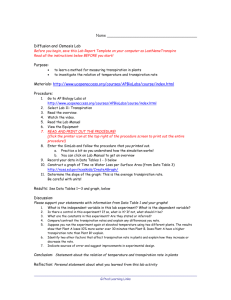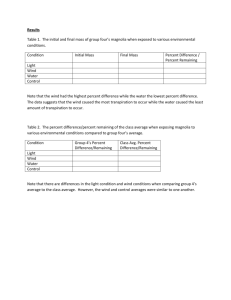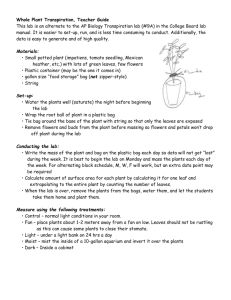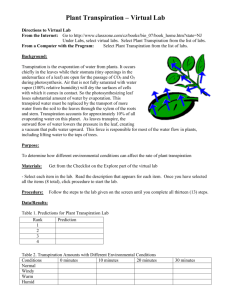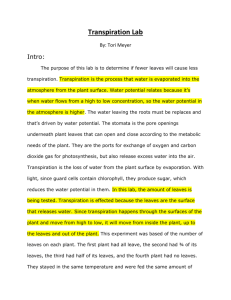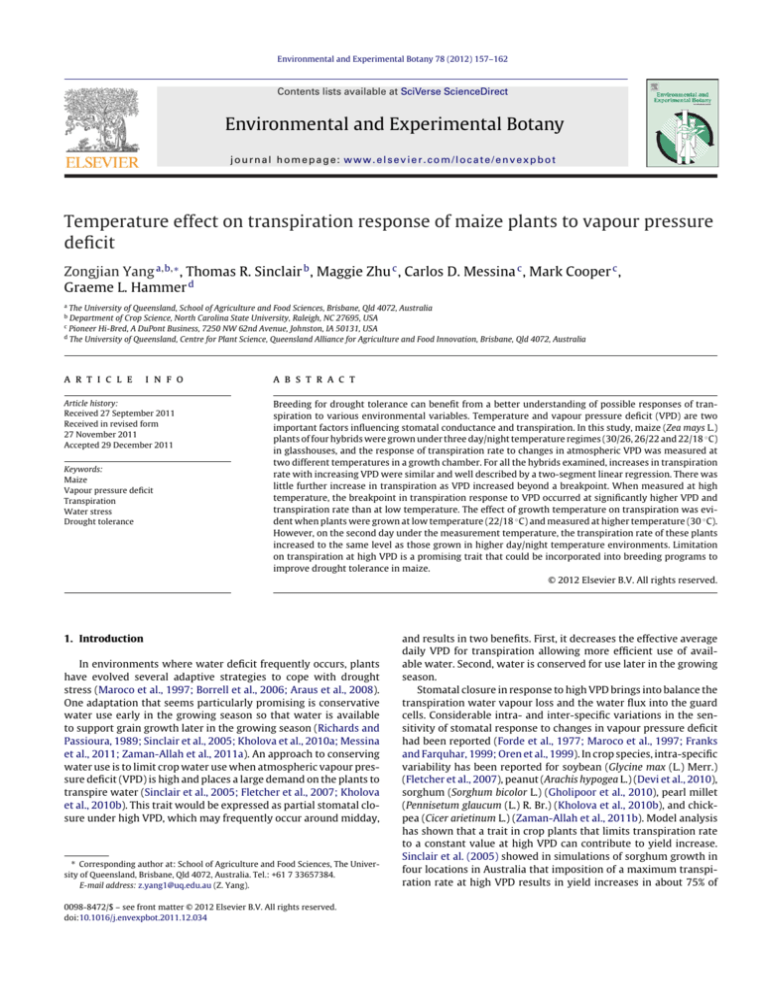
Environmental and Experimental Botany 78 (2012) 157–162
Contents lists available at SciVerse ScienceDirect
Environmental and Experimental Botany
journal homepage: www.elsevier.com/locate/envexpbot
Temperature effect on transpiration response of maize plants to vapour pressure
deficit
Zongjian Yang a,b,∗ , Thomas R. Sinclair b , Maggie Zhu c , Carlos D. Messina c , Mark Cooper c ,
Graeme L. Hammer d
a
The University of Queensland, School of Agriculture and Food Sciences, Brisbane, Qld 4072, Australia
Department of Crop Science, North Carolina State University, Raleigh, NC 27695, USA
c
Pioneer Hi-Bred, A DuPont Business, 7250 NW 62nd Avenue, Johnston, IA 50131, USA
d
The University of Queensland, Centre for Plant Science, Queensland Alliance for Agriculture and Food Innovation, Brisbane, Qld 4072, Australia
b
a r t i c l e
i n f o
Article history:
Received 27 September 2011
Received in revised form
27 November 2011
Accepted 29 December 2011
Keywords:
Maize
Vapour pressure deficit
Transpiration
Water stress
Drought tolerance
a b s t r a c t
Breeding for drought tolerance can benefit from a better understanding of possible responses of transpiration to various environmental variables. Temperature and vapour pressure deficit (VPD) are two
important factors influencing stomatal conductance and transpiration. In this study, maize (Zea mays L.)
plants of four hybrids were grown under three day/night temperature regimes (30/26, 26/22 and 22/18 ◦ C)
in glasshouses, and the response of transpiration rate to changes in atmospheric VPD was measured at
two different temperatures in a growth chamber. For all the hybrids examined, increases in transpiration
rate with increasing VPD were similar and well described by a two-segment linear regression. There was
little further increase in transpiration as VPD increased beyond a breakpoint. When measured at high
temperature, the breakpoint in transpiration response to VPD occurred at significantly higher VPD and
transpiration rate than at low temperature. The effect of growth temperature on transpiration was evident when plants were grown at low temperature (22/18 ◦ C) and measured at higher temperature (30 ◦ C).
However, on the second day under the measurement temperature, the transpiration rate of these plants
increased to the same level as those grown in higher day/night temperature environments. Limitation
on transpiration at high VPD is a promising trait that could be incorporated into breeding programs to
improve drought tolerance in maize.
© 2012 Elsevier B.V. All rights reserved.
1. Introduction
In environments where water deficit frequently occurs, plants
have evolved several adaptive strategies to cope with drought
stress (Maroco et al., 1997; Borrell et al., 2006; Araus et al., 2008).
One adaptation that seems particularly promising is conservative
water use early in the growing season so that water is available
to support grain growth later in the growing season (Richards and
Passioura, 1989; Sinclair et al., 2005; Kholova et al., 2010a; Messina
et al., 2011; Zaman-Allah et al., 2011a). An approach to conserving
water use is to limit crop water use when atmospheric vapour pressure deficit (VPD) is high and places a large demand on the plants to
transpire water (Sinclair et al., 2005; Fletcher et al., 2007; Kholova
et al., 2010b). This trait would be expressed as partial stomatal closure under high VPD, which may frequently occur around midday,
∗ Corresponding author at: School of Agriculture and Food Sciences, The University of Queensland, Brisbane, Qld 4072, Australia. Tel.: +61 7 33657384.
E-mail address: z.yang1@uq.edu.au (Z. Yang).
0098-8472/$ – see front matter © 2012 Elsevier B.V. All rights reserved.
doi:10.1016/j.envexpbot.2011.12.034
and results in two benefits. First, it decreases the effective average
daily VPD for transpiration allowing more efficient use of available water. Second, water is conserved for use later in the growing
season.
Stomatal closure in response to high VPD brings into balance the
transpiration water vapour loss and the water flux into the guard
cells. Considerable intra- and inter-specific variations in the sensitivity of stomatal response to changes in vapour pressure deficit
had been reported (Forde et al., 1977; Maroco et al., 1997; Franks
and Farquhar, 1999; Oren et al., 1999). In crop species, intra-specific
variability has been reported for soybean (Glycine max (L.) Merr.)
(Fletcher et al., 2007), peanut (Arachis hypogea L.) (Devi et al., 2010),
sorghum (Sorghum bicolor L.) (Gholipoor et al., 2010), pearl millet
(Pennisetum glaucum (L.) R. Br.) (Kholova et al., 2010b), and chickpea (Cicer arietinum L.) (Zaman-Allah et al., 2011b). Model analysis
has shown that a trait in crop plants that limits transpiration rate
to a constant value at high VPD can contribute to yield increase.
Sinclair et al. (2005) showed in simulations of sorghum growth in
four locations in Australia that imposition of a maximum transpiration rate at high VPD results in yield increases in about 75% of
158
Z. Yang et al. / Environmental and Experimental Botany 78 (2012) 157–162
the growing seasons. Similarly, Sinclair et al. (2010) found for soybean in the U.S. that yield was increased in over 70% of the growing
seasons for most locations in the U.S.
Stomatal response is considered to be related to the hydraulic
dynamics in the plant. High water vapour loss from guard cells
and/or a shortage of water supply to the epidermal cells, including
the guard cells in particular, can result in decreased turgor pressure and cause partial stomata closure (Mott and Parkhurst, 1991;
Eamus et al., 2008). Transpiration restriction by stomata at high VPD
appears to result from limiting hydraulic conductance in the plant,
which constrains the flow of water from roots to transpiration sites
in the leaf surface (Brodribb and Jordan, 2008; Sinclair et al., 2008;
Sadok and Sinclair, 2010). A substantial portion of the hydraulic
resistance can be located in the leaf, especially the extravascular
component (Matzner and Comstock, 2001; Cochard et al., 2004;
Mott, 2007). There is also evidence of resistance residing in roots
(Parent et al., 2009). Abscisic acid has been implicated in the mediation of the conductance response to VPD (Bunce, 1997; Thompson
et al., 2007; Kholova et al., 2010b). Water channel proteins, aquaporins, are responsible for the trans-membrane water movement
and as such play an important role in the regulation of extravascular
water transport (Nardini et al., 2005; Tyree et al., 2005; Parent et al.,
2009; Ionenko et al., 2010). Level and activity of aquaporins can
affect hydraulic conductivity and result in restricted transpiration
at high VPD.
The involvement of aquaporins in influencing hydraulic conductance opens the potential for sensitivity of maximum transpiration
capacity to various environmental factors such as temperature and
irradiance (Nardini et al., 2005; Tyree et al., 2005; Ionenko et al.,
2010). Temperature changes not only directly affect VPD but can
also result in changes in plant hydraulic conductance and water
supply to the leaf surface (Willmer and Fricker, 1996; Fredeen
and Sage, 1999; Matzner and Comstock, 2001; Sack and Holbrook,
2006). The effect of temperature on plant internal hydraulic
conductivity could operate partially through the sensitivity of aquaporin to temperature. It has been reported in several species that
aquaporin phosphorylation and gene expression respond to temperature (Cochard et al., 2007; Murai-Hatano et al., 2008; Ionenko
et al., 2010).
A recent study of 34 maize (Zea mays L.) hybrids showed also that
this species had considerable genetic variability in the existence of
a limited maximum transpiration trait (Gholipoor and Sinclair et al.,
unpub. data). Twelve of the 34 hybrids expressed restricted transpiration rates above VPD ranging from 1.7 to 2.5 kPa when measured
at a temperature of about 31.5 ◦ C. An important unanswered question is whether the response to VPD observed for these maize
hybrids also exists at other temperatures that the crop may experience in the field. In the present study, four hybrids that expressed
the maximum transpiration trait were selected from the previous study to determine the possible transpiration response when
grown and tested under different temperatures. The objective was
to understand how growth and measurement temperatures affect
transpiration response of maize plants to changes in atmospheric
VPD. Such knowledge will allow a better assessment of the possible benefit of using the maximum transpiration trait to improve
drought tolerance in maize in environments where water deficit,
vapour pressure deficit and temperature can affect the crop water
balance and productivity.
2. Materials and methods
2.1. Plant materials and growth conditions
Maize (Zea mays L.) hybrids – PHYBTS010, PHYBTS013,
PHYBTS017 and PHYBTS021 – were selected from the study of
Gholipoor and Sinclair et al. (unpub. data) based on their expression of maximum transpiration trait at high VPD. Plants were
grown in polyvinyl chloride (PVC) pots (10-cm diameter, 33-cm
tall) filled with compost garden soil (Miracle-Grolawn Products,
Inc., Marysville, OH) that contained slow release fertilizer. The pots
were placed in three separate glasshouses of the Phytotron at North
Carolina State University, Raleigh, NC. The glasshouses were controlled at day/night air temperatures of 30/26, 26/22, or 22/18 ◦ C.
In each glasshouse, two sets of plants were grown for testing at two
different subsequent temperatures. The pots were over-sown and
thinned to one plant per pot at 6 days after sowing. The plants were
maintained in well-watered condition.
2.2. VPD control and transpiration response measurement
Transpiration measurements were conducted on plants 2–3
weeks old with total leaf area of 300–400 cm2 . Since the development rate of the plants was influenced by glasshouse temperature,
the first set of plants to be measured were those grown under high
temperature followed by plants grown under successively lower
temperature. This allowed more equality in plant size at the time
transpiration response was measured. Late in the day before measuring transpiration rates, pots were watered until dripping and 12
selected plants (three replicates for each hybrid) were transferred
into a walk-in growth chamber of the Phytotron. Pots were left in
the growth chamber overnight for drainage of excess water and
equivalence of soil temperature.
The night temperature in the growth chamber was set at 25 ◦ C
for measurement at 30 ◦ C, and 20 ◦ C for measurement at 25 ◦ C. The
morning before the beginning of the transpiration measurements,
the soil surface of each PVC pot was covered with aluminum foil
and plastic wrap and the pot bottom was sealed with a plastic bag
to minimize water evaporation from the soil during measurements.
Each plant shoot was enclosed in a 21 l transparent plastic container
(Cambro Manufacturing, Huntington Beach, CA) that was loosely
attached to the top of the PVC pots. Air entered the chamber above
the plants and flowed through the chamber and escaped the chamber at the bottom above the soil surface. Each plant chamber was
equipped with a 12-V, 76-mm-diameter computer box fan (Northern Tool and Equipment, Burnsville, MN) to continuously mix the
air inside the plant chamber. An EL-USB data logger (Lascar Electronics, Erie, PA) was placed through a hole in the side wall of
the container to record temperature and relative humidity every
minute.
At each measurement temperature, the desired range of VPD
was achieved by control of the air flow rate and air source into the
chambers. The rate of air flow into the plant chambers was monitored with flow meters, one for each chamber (Model FL-2043,
Omega, Stamford, CT). The low and medium VPD was obtained by
flowing ambient air through the chambers at different rates. For
high VPD treatment, the air was first passed through a PVC column
(5-cm diameter, 120-cm length) filled with Silica Gel Desiccant
(Fisher Scientific, Fair Lawn, NJ). Calculation of VPD for each chamber was based on the averaged temperature and relative humidity
during the measurement period.
Transpiration rates were measured on 2 consecutive days. Plants
were subjected to four levels of VPD each day. Pots were re-watered
at the end of the first day. Each day, measurements started from low
VPD followed successively by higher VPD. Plants were allowed to
acclimate to each humidity treatment for at least 30 min before the
initial weight of the pot was measured. Water loss was determined
by changes in pot weight that occurred during exposure to each
VPD treatment for 1 h. After measurements were completed on the
second day, total leaf area of each plant was measured using a leaf
Z. Yang et al. / Environmental and Experimental Botany 78 (2012) 157–162
159
Table 1
Best linear unbiased predictions for parameters of the two-segment linear model that describe the transpiration responses of maize plants to atmospheric VPD. Maize plants
of four hybrids were grown under three different day/night temperatures and transpiration rates were measured at two different temperatures. For each measurement
temperature, data from plants of different growth temperatures were combined to fit the two-segment linear model except for the first day of measurement conducted at
30 ◦ C on plants grown under 22/18 ◦ C.
Measurement temperature (◦ C)
Genotype
Breakpoint (kPa)
Slope (a1 )a (mg H2 O m−2 s−1 kPa−1 )
30
PHYBTS010
PHYBTS013
PHYBTS017
PHYBTS021
2.08
2.13
2.19
2.04
18.01
19.45
19.22
18.16
25
PHYBTS010
PHYBTS013
PHYBTS017
PHYBTS021
1.75
1.81
1.86
1.72
18.60
20.04
19.80
18.75
Standard error of prediction
a
0.037
0.25
Slope of transpiration response to VPD below the breakpoint (see Eq. (1)).
area meter (LI-3100, LI-COR, Lincoln, NE). Transpiration rate was
expressed as water loss per unit time divided by plant leaf area.
2.3. Data analysis
For each combination of hybrid, growth temperature, and measurement temperature, a two-segment linear regression model was
used to describe transpiration rate (TR) data in response to VPD:
TR = b1 + a1 VPD (for VPD < BP)
(1)
TR = b2 + a2 VPD (for VPD ≥ BP)
(2)
where a1 and a2 are the slopes, b1 and b2 the intercepts of the
two linear segments, respectively. BP is the value of VPD at the
breakpoint where the two linear segments intersected. The twosegment model selected ensured that the two linear segments
intercepted at a breakpoint (BP) determined in the regression analysis (b1 + a1 BP = b2 + a2 BP).
Statistical analyses were conducted in two stages. First, a twosegment linear model (Eqs. (1) and (2)) was fit within a mixed
model framework. All parameters in the model were considered as
random effects with a diagonal variance structure. Model parameters were estimated using the maximum likelihood function in
the R package nlme. Variance components for random effects were
assessed and terms with small variance were included in the mixed
model as fixed effects (a2 in Eq. (2)). Best linear unbiased predictions (BLUP) were calculated for each hybrid, measurement
temperature and growth temperature combination. At the second
Fig. 1. Response of transpiration rates of maize hybrid PHYBTS010 (A and B) and PHYBTS021 (C and D) to increasing atmospheric vapour pressure deficit. Plants were grown
under day/night temperatures of 30/26 ◦ C (closed circles), 26/22 ◦ C (open triangles) and 22/18 ◦ C (open circles); and transpiration rates were measured at 25 ◦ C (A and C) and
30 ◦ C (B and D). For each measurement temperature, data from plants of different growth temperatures were combined to fit the two-segment linear model except for the
first day of measurement conducted at 30 ◦ C on plants grown under 22/18 ◦ C.
160
Z. Yang et al. / Environmental and Experimental Botany 78 (2012) 157–162
Fig. 2. Response of transpiration rates of maize hybrid PHYBTS013 (A and B) and PHYBTS017 (C and D) to increasing atmospheric vapour pressure deficit. Plants were grown
under day/night temperatures of 30/26 ◦ C (closed circles), 26/22 ◦ C (open triangles) and 22/18 ◦ C (open circles); and transpiration rates were measured at 25 ◦ C (A and C) and
30 ◦ C (B and D). For each measurement temperature, data from plants of different growth temperatures were combined to fit the two-segment linear model except for the
first day of measurement conducted at 30 ◦ C on plants grown under 22/18 ◦ C.
Fig. 3. Response of transpiration rates of maize hybrid PHYBTS013 (A), PHYBTS017 (B), PHYBTS010 (C) and PHYBTS021 (D) to increasing atmospheric vapour pressure deficit,
showing the difference between the 2 consecutive days of measurements when plants were grown under 22/18 ◦ C and transpiration rates were measured at 30 ◦ C.
Z. Yang et al. / Environmental and Experimental Botany 78 (2012) 157–162
stage, the dependence of these BLUPs on measurement temperature, growth temperature and hybrid is analyzed within a mixed
model framework with growth and measurement temperature
considered as fixed effects and hybrid as random effects. Parameters were estimated using the R package asreml. The first day of
measurement conducted at 30 ◦ C on plants grown under 22/18 ◦ C
showed a distinctive behavior and were not included in the analyses.
3. Results
3.1. Two-segment linear response of transpiration rate to
increasing VPD
Results of transpiration response to VPD obtained over 2 days
of measurement conformed with each other and showed the same
pattern of response, except for the single case of plants grown at
22/18 ◦ C and measured at 30 ◦ C (Figs. 1 and 2). The response of
transpiration rate to VPD exhibited a non-linear pattern with a
clear breakpoint for all four hybrids examined (Figs. 1 and 2). Linear and two-segment linear mixed models were compared using
likelihood ratio test. Results indicate that the two-segment linear model describe the transpiration response to VPD significantly
better than a linear model (p < 0.0001).
Generally, transpiration rate increased with increasing VPD at
a rate of 19.0 mg H2 O m−2 s−1 kPa−1 when VPD was lower than
the breakpoint. Above the breakpoint, the slope of transpiration
response to VPD decreased from 19.0 to 9.4 mg H2 O m−2 s−1 kPa−1 .
No significant genotypic differences were detected in the slopes
of transpiration response to VPD at either low or high VPD. The
variance component for the slopes at high VPD (a2 in Eq. (2))
was virtually zero, so it was considered as fixed effect in the
mixed-model analyses. Similarly, there was no significant difference among hybrids in the VPD value for the breakpoint within a
measurement temperature (Table 1).
3.2. The effect of growth temperature
An effect of growth temperature was evident in the case of
plants grown at 22/18 ◦ C and measured at 30 ◦ C. On the first day of
measurements of these plants, their transpiration rates were significantly lower than that of plants grown at 30/26 and 26/22 ◦ C
(Fig. 3). On the second day of measurement of these plants, however, their transpiration rate increased to the same level as those
grown in higher day/night temperature environments. Except for
the first day of measurement conducted at 30 ◦ C on plants grown
under 22/18 ◦ C, the main effect of growth temperature was small
with slight influence on the slope of transpiration response (a1 in
Eq. (1)) when VPD was lower than the breakpoint (P(2 ) < 9 × 10−9 ).
3.3. The effect of measurement temperature
Measurement temperatures had small but detectable effects
on the slope of transpiration response to VPD (P(2 ) = 0.0015)
(Table 1). In contrast, a marked effect of measurement temperature
was detected on the location of the breakpoint (P(2 ) < 2 × 10−16 ).
The breakpoint occurred at a significantly higher VPD and transpiration rate for measurement conducted at 30 ◦ C as compared to
measurement at 25 ◦ C (Table 1, Figs. 1 and 2).
161
and Sinclair et al., unpub. data) identifying these hybrids as exhibiting the two-segment response to increasing VPD. In the current
study, the response of transpiration to VPD was tested under additional growth temperatures and measurement temperatures. The
results showed that in these hybrids the two-segment response
occurred under all tested temperature conditions.
In all but one set of growth/measurement temperature, a common two-segment regression was found for the data obtained on
the 2 days of measurement (Table 1). That is, acclimation of the
gas exchange capacity from the growth temperature to the measurement temperature was rapid. Acclimation occurred within the
previous night in the growth chamber plus the first hours at the
measurement temperature. Fast acclimation following the changes
in ambient temperature has also been reported for physiological
processes such as photosynthesis and respiration (Bjorkman et al.,
1980; Tranquillini et al., 1986; Atkin and Tjoelker, 2003). The rapid
acclimation of transpiration capacity following changes in ambient
temperature indicated that limitation on transpiration induced by
growth temperature was biochemical rather than anatomical.
The acclimation to measurement temperature was longer for
all hybrids when the plants were grown under low temperature
(22/18 ◦ C) and measured at the higher temperature of 30 ◦ C in the
growth chamber. The slope of the transpiration response at low
VPD increased from the first day of measurement to the second
(Fig. 3). Assuming the slope of the increase in transpiration rate
reflects stomatal aperture, transfer of the plants from 22/18 ◦ C to
30/25 ◦ C required a full day to achieve acclimation in gas exchange
capacity.
The ambient temperature at the time of measurement had a
large influence on the location of the breakpoint of the transpiration
rate response to VPD. The breakpoint for transpiration response
shifted to higher levels of both VPD and transpiration rate for measurements at 30 ◦ C as compared to at 25 ◦ C (Table 1). The shift in the
breakpoint is likely to be caused by temperature-induced changes
in the water supply rate to the transpiration sites in the leaf surface. As leaf and root temperature was increased, it is hypothesized
that plant hydraulic conductance increased due to temperaturedependent changes in both membrane permeability and water
viscosity (Fredeen and Sage, 1999; Matzner and Comstock, 2001;
Sack and Holbrook, 2006). Previous studies indicate that limiting
hydraulic conductance may constrain water flow to the leaf surface
and cause partial stomatal closure when the potential transpiration rate is high (Brodribb and Jordan, 2008; Sinclair et al., 2008;
Parent et al., 2009; Sadok and Sinclair, 2010). Temperature-induced
increases in hydraulic conductance would increase water supply to
guard cells and allow greater stomatal aperture and conductance
(Collatz et al., 1991; Mott and Parkhurst, 1991; Monteith, 1995). As
a consequence, plants under higher temperature would be able to
maintain a stable leaf water potential at higher VPD before stomatal
closure occurs at the breakpoint.
Aquaporins may play an important role in regulation of plant
internal hydraulic conductivity in response to ambient temperature in these four hybrids. Previous studies in several species
have shown that aquaporins are involved in temperature-induced
changes in plant hydraulic conductance (Lee and Chung, 2005;
Murai-Hatano et al., 2008). It has been reported that aquaporin
phosphorylation and gene expression respond to temperature
(Cochard et al., 2007; Murai-Hatano et al., 2008).
5. Conclusion
4. Discussion
The four hybrids included in this study showed limitation on
increase in transpiration rates at high VPD above a breakpoint.
These results confirmed the results of the previous study (Gholipoor
Conservative use of water through mechanism of transpiration
regulation is considered to be an important adaptive strategy for
plants growing in drought-prone environments. Some hybrids of
maize showed limitation on increase in transpiration rate at high
162
Z. Yang et al. / Environmental and Experimental Botany 78 (2012) 157–162
VPD above a breakpoint, and this pattern of transpiration response
exists under a range of temperatures that the crop may experience in the field. Transpiration restriction could operate through
anatomical or physiological features. A better understanding of the
mechanism of transpiration regulation in these hybrids will assist
in breeding to improve drought tolerance in maize using the transpiration restriction trait.
Acknowledgment
We thank Tom Seversike, Shannon Sermons and the staff of Phytotron at North Carolina State University for technical assistance.
References
Araus, J.L., Slafer, G.A., Royo, C., Serret, M.D., 2008. Breeding for yield potential and
stress adaptation in cereals. Crit. Rev. Plant Sci. 27, 377–412.
Atkin, O.K., Tjoelker, M.G., 2003. Thermal acclimation and the dynamic response of
plant respiration to temperature. Trends Plant Sci. 8, 343–351.
Bjorkman, O., Badger, M.R., Armond, P.A., 1980. Response and adaptation of photosynthesis to high temperature. In: Turner, N.C., Kramer, P.J. (Eds.), Adaptation of
Plants to Water and High Temperature Stress. John Wiley & Sons, New York, pp.
233–249.
Borrell, A., Jordan, D., Mullet, J., Henzell, B., Hammer, G., 2006. Drought adaptation
in sorghum. In: Ribaut, J.M. (Ed.), Drought Adaptation in Cereals. The Haworth
Press, Binghamton, USA, pp. 335–399.
T.J.,
Jordan,
G.J.,
2008.
Internal
coordination
between
Brodribb,
hydraulics and stomatal control in leaves. Plant Cell Environ. 31,
1557–1564.
Bunce, J.A., 1997. Does transpiration control stomatal responses to water vapour
pressure deficit. Plant Cell Environ. 20, 131–135.
Cochard, H., Nardini, A., Coll, L., 2004. Hydraulic architecture of leaf blades: where
is the main resistance. Plant Cell Environ. 27, 1257–1267.
Cochard, H., Venisse, J.S., Barigah, T.S., Brunel, N., Herbette, S., Guilliot, A., Tyree, M.T.,
Sakr, S., 2007. Putative role of aquaporins in variable hydraulic conductance of
leaves in response to light. Plant Physiol. 143, 122–133.
Collatz, G.J., Ball, J.T., Grivet, C., Berry, J.A., 1991. Physiological and environmental
regulation of stomatal conductance, photosynthesis and transpiration: a model
that includes a laminar boundary layer. Agric. For. Met. 54, 107–136.
Devi, M.J., Sinclair, T.R., Vadez, V., 2010. Genotypic variation in peanut for transpiration response to vapor pressure deficit. Crop Sci. 50, 191–196.
Eamus, D., Taylor, D.T., Macinnis-Ng, C.M.O., Shanahan, S., De Silva, L., 2008. Comparing model predictions and experimental data for the response of stomatal
conductance and guard cell turgor to manipulations of cuticular conductance,
leaf-to-air vapour pressure difference and temperature: feedback mechanisms
are able to account for all observations. Plant Cell Environ. 31, 269–277.
Fletcher, A.L., Sinclair, T.R., Allen, L.H., 2007. Transpiration responses to vapor pressure deficit in well watered ‘slow-wilting’ and commercial soybean. Environ.
Exp. Bot. 61, 145–151.
Forde, B.J., Mitchell, K.J., Edge, E.A., 1977. Effect of temperature, vapour-pressure
deficit and irradiance on transpiration rates of maize, paspalum, westerwolds
and perennial ryegrasses, peas, white clover and lucerne. Aust. J. Plant Physiol.
4, 889–899.
Franks, P.J., Farquhar, G.D., 1999. A relationship between humidity response, growth
form and photosynthetic operating point in C3 plants. Plant Cell Environ. 22,
1337–1349.
Fredeen, A.L., Sage, R.F., 1999. Temperature and humidity effects on branchlet gas-exchange in white spruce: an explanation for the increase
in transpiration with branchlet temperature. Trees-Struct. Funct. 14,
161–168.
Gholipoor, M., Prasad, P.V.V., Mutava, R.N., Sinclair, T.R., 2010. Genetic variability
of transpiration response to vapor pressure deficit among sorghum genotypes.
Field Crops Res 119, 85–90.
Ionenko, I.F., Anisimov, A.V., Dautova, N.R., 2010. Effect of temperature on water
transport through aquaporins. Biol. Plant. 54, 488–494.
Kholova, J., Hash, C.T., Kakkera, A., Kocova, M., Vadez, V., 2010a. Constitutive waterconserving mechanisms are correlated with the terminal drought tolerance of
pearl millet [Pennisetum glaucum (L.) R. Br.]. J. Exp. Bot. 61, 369–377.
Kholova, J., Hash, C.T., Kumar, P.L., Yadav, R.S., Kocova, M., Vadez, V., 2010b. Terminal
drought-tolerant pearl millet [Pennisetum glaucum (L.) R. Br.] have high leaf ABA
and limit transpiration at high vapour pressure deficit. J. Exp. Bot. 61, 1431–1440.
Lee, S.H., Chung, G.C., 2005. Sensitivity of root system to low temperature appears
to be associated with the root hydraulic properties through aquaporin activity.
Sci. Hort. 105, 1–11.
Maroco, J.P., Pereira, J.S., Chaves, M.M., 1997. Stomatal responses to leaf-to-air
vapour pressure deficit in sahelian species. Aust. J. Plant Physiol. 24, 381–387.
Matzner, S., Comstock, J., 2001. The temperature dependence of shoot hydraulic
resistance: implications for stomatal behaviour and hydraulic limitation. Plant
Cell Environ. 24, 1299–1307.
Messina, C.D., Podlich, D., Dong, Z.S., Samples, M., Cooper, M., 2011. Yield-trait performance landscapes: from theory to application in breeding maize for drought
tolerance. J. Exp. Bot. 62, 855–868.
Monteith, J.L., 1995. A reinterpretation of stomatal responses to humidity. Plant Cell
Environ. 18, 357–364.
Mott, K.A., 2007. Leaf hydraulic conductivity and stomatal responses to humidity in
amphistomatous leaves. Plant Cell Environ. 30, 1444–1449.
Mott, K.A., Parkhurst, D.F., 1991. Stomatal responses to humidity in air and helox.
Plant Cell Environ. 14, 509–515.
Murai-Hatano, M., Kuwagata, T., Sakurai, J., Nonami, H., Ahamed, A., Nagasuga, K.,
Matsunami, T., Fukushi, K., Maeshima, M., Okada, M., 2008. Effect of low root
temperature on hydraulic conductivity of rice plants and the possible role of
aquaporins. Plant Cell Physiol. 49, 1294–1305.
Nardini, A., Salleo, S., Andri, S., 2005. Circadian regulation of leaf hydraulic conductance in sunflower (Helianthus annuus L. cv. Margot). Plant Cell Environ. 28,
750–759.
Oren, R., Sperry, J.S., Katul, G.G., Pataki, D.E., Ewers, B.E., Phillips, N., Schafer, K.V.R.,
1999. Survey and synthesis of intra- and interspecific variation in stomatal sensitivity to vapour pressure deficit. Plant Cell Environ. 22, 1515–1526.
Parent, B., Hachez, C., Redondo, E., Simonneau, T., Chaumont, F., Tardieu, F., 2009.
Drought and abscisic acid effects on aquaporin content translate into changes
in hydraulic conductivity and leaf growth rate: a trans-scale approach. Plant
Physiol. 149, 2000–2012.
Richards, R.A., Passioura, J.B., 1989. A breeding program to reduce the diameter of
the major xylem vessel in the seminal roots of wheat and its effect on grain yield
in rain-fed environments. Aust. J. Agric. Res. 40, 943–950.
Sack, L., Holbrook, N.M., 2006. Leaf hydraulics. Annu. Rev. Plant Biol. 57, 361–381.
Sadok, W., Sinclair, T.R., 2010. Transpiration response of ‘slow-wilting’ and commercial soybean (Glycine max (L.) Merr.) genotypes to three aquaporin inhibitors. J.
Exp. Bot. 61, 821–829.
Sinclair, T.R., Hammer, G.L., van Oosterom, E.J., 2005. Potential yield and water-use
efficiency benefits in sorghum from limited maximum transpiration rate. Funct.
Plant Biol. 32, 945–952.
Sinclair, T.R., Messina, C.D., Beatty, A., Samples, M., 2010. Assessment across the
United States of the benefits of altered soybean drought traits. Agron. J. 102,
475–482.
Sinclair, T.R., Zwieniecki, M.A., Holbrook, N.M., 2008. Low leaf hydraulic conductance
associated with drought tolerance in soybean. Physiol. Plant. 132, 446–451.
Thompson, A.J., Andrews, J., Mulholland, B.J., McKee, J.M.T., Hilton, H.W., Black, C.R.,
Taylor, I.B., 2007. Overproduction of abscisic acid in tomato increases transpiration efficiency and root hydraulic conductivity and influences leaf expansion.
Plant Physiol. 143, 1905–1917.
Tranquillini, W., Havranek, W.M., Ecker, P., 1986. Effects of atmospheric humidity
and acclimation temperature on the temperature response of photosynthesis in
young Larix decidua Mill. Tree Physiol. 1, 37–45.
Tyree, M.T., Nardini, A., Salleo, S., Sack, L., El Omari, B., 2005. The dependence of leaf
hydraulic conductance on irradiance during HPFM measurements: any role for
stomatal response. J. Exp. Bot. 56, 737–744.
Willmer, C., Fricker, M., 1996. Stomata, 2nd ed. Chapman & Hall, London, UK.
Zaman-Allah, M., Jenkinson, D.M., Vadez, V., 2011a. A conservative pattern of water
use, rather than deep or profuse rooting, is critical for the terminal drought
tolerance of chickpea. J. Exp. Bot. 62, 4239–4252.
Zaman-Allah, M., Jenkinson, D.M., Vadez, V., 2011b. Chickpea genotypes contrasting
for seed yield under terminal drought stress in the field differ for traits related
to the control of water use. Funct. Plant Biol. 38, 270–281.


